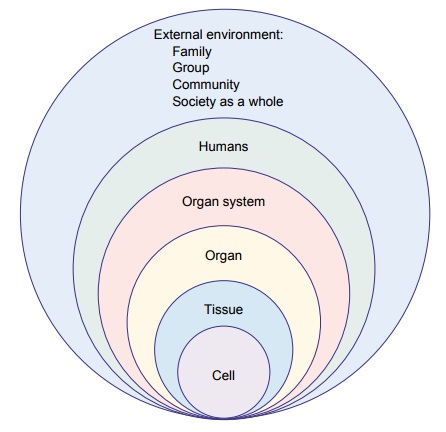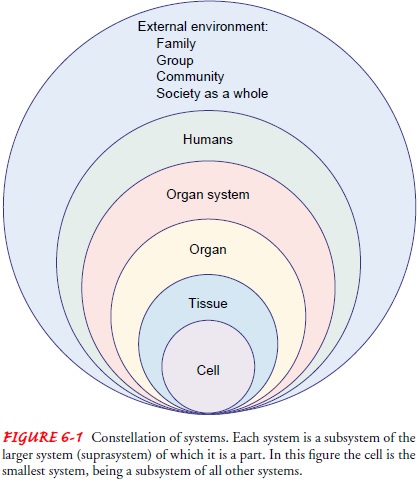Chapter: Medical Surgical Nursing: Homeostasis, Stress, and Adaptation
Dynamic Balance: The Steady State

Dynamic Balance: The Steady State
Physiologic mechanisms
must be understood in the context of the body as a whole. The person, as a
living system, has both an in-ternal and an external environment, between which
information
Within the internal environment each organ, tissue, and
cell is also a system or sub-system of the whole, each with its own internal
and external en-vironment, each exchanging information and matter (Fig. 6-1).
The goal of the interaction of the body’s subsystems is to pro-duce a dynamic
balance or steady state (even in the
presence of change), so that all subsystems are in harmony with each other.
Four concepts—constancy, homeostasis, stress, and adaptation— enhance the
nurse’s understanding of steady state.

HISTORICAL THEORIES OF THE STEADY STATE
Claude Bernard, a
19th-century French physiologist, developed the biologic principle that for
life there must be a constancy or “fixity of the internal milieu” despite
changes in the external en-vironment. The internal milieu was the fluid that
bathed the cells, and the constancy was the balanced internal state maintained
by physiologic and biochemical processes. His principle implied a static
process.
Later, Walter Cannon
used the term homeostasis to describe
the stability of the internal environment, which, he said, was co-ordinated by
homeostatic or compensatory processes that re-sponded to changes in the
internal environment. Any change within the internal environment initiated a
“righting” response to minimize the change. These biologic processes sought
physio-logic and chemical balance and were under involuntary control.
Rene Jules Dubos (1965)
provided further insight into the dy-namic nature of the internal environment
with his theory that two complementary concepts, homeostasis and adaptation,
were necessary for balance. Homeostatic processes occurred quickly in response
to stress, rapidly making the adjustments necessary to maintain the internal
environment. Adaptive processes resulted in structural or functional changes
over time. Dubos also em-phasized that acceptable ranges of response to stimuli
existed and that these responses varied for different individuals: “Absolute
constancy is only a concept of the ideal.” Homeostasis and adap-tation were
both necessary for survival in a changing world.
Homeostasis, then,
refers to a steady state within the body. When a change or stress occurs that
causes a body function to de-viate from its stable range, processes are
initiated to restore and maintain the dynamic balance. When these adjustment
processes or compensatory mechanisms are not adequate, the steady state is threatened,
function becomes disordered, and pathophysio-logic mechanisms occur. The
pathophysiologic processes can lead to disease and may be active during
disease, which is a threat to the steady state. Disease is an abnormal
variation in the structure or function of any part of the body. It disrupts
function and therefore limits the person’s freedom of action.
STRESS AND ADAPTATION
Stress is a state produced by a change in the
environment that isperceived as challenging, threatening, or damaging to the per-son’s
dynamic balance or equilibrium. The person is, or feels, un-able to meet the
demands of the new situation. The change or stimulus that evokes this state is
the stressor. The nature of the stressor is variable; an event or change that
will produce stress in one person may be neutral for another, and an event that
pro-duces stress at one time and place for one person may not do so for the
same person at another time and place. A person appraises and copes with
changing situations. The desired goal is adapta-tion,
or adjustment to the change so that the person is again inequilibrium and has
the energy and ability to meet new demands. This is the process of coping with the stress, a compensatory
process with physiologic and psychological components.
Adaptation is a
constant, ongoing process that requires a change in structure, function, or
behavior so that the person is better suited to the environment; it involves an
interaction between the person and the environment. The outcome depends on the
de-gree of “fit” between the skills and capacities of the person, the type of
social support available, and the various challenges or stressors being
confronted. As such, adaptation is an individual process: each individual has
varying abilities to cope or respond. As new challenges are met, this ability
to cope and adapt can change, thereby providing the individual with a wide
range of adaptive ability. Adaptation occurs throughout the life span as the
individual encounters many developmental and situational chal-lenges,
especially related to health and illness. The goal of these encounters is to
promote adaptation. In situations of health and illness, this goal is realized
by optimal wellness.
Because both stress and
adaptation may exist at different lev-els of a system, it is possible to study
these reactions at the cellu-lar, tissue, and organ levels. Biologists are
concerned mainly with subcellular components or with subsystems of the total
body. Be-havioral scientists, including many nurse researchers, study stress
and adaptation in individuals, families, groups, and societies; they focus on
how a group’s organizational features are modified to meet the requirements of
the social and physical environment in which they exist. Adaptation is a
continuous process of seeking harmony in an environment. The desired goals of
adaptation for any system are survival, growth, and reproduction.
Related Topics